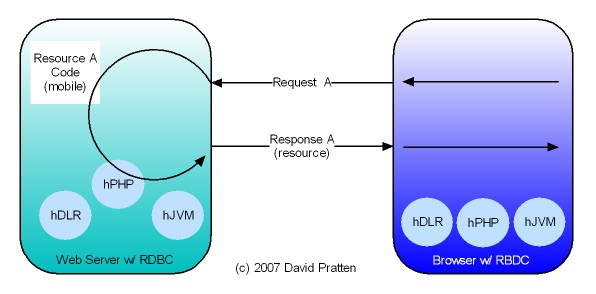Good to be blogging again after a three month hiatus. The Work Breakdown Structure has caught my attention. The work breakdown structure is foundational to project management. My insight today is that the WBS could also be foundation to a task … [Continue reading]
Signless One-way Paths for Pedestrians

When I was at university getting from class to class between buildings meant fighting your way along a footpath against a flow of students coming the opposite direction. Solutions? You could widen the path (more concrete) or redesign the pathway … [Continue reading]
Adaptive Shop Facades
If all our building's internal walls, signage as well as dynamic displays where flat panel displays what would happen?I was walking through a mall a few days ago and realised that pretty much all that I could see around me could be displayed on flat … [Continue reading]
Internet All The Way Down
"STEPS Toward The Reinvention of Programming"[linkmoved] has a great piece about the promise of a uniform model of computation based on arbitrary decomposition to the internet. On p32 they say: Part of the solution to œan Internet all the way down … [Continue reading]
Omniface or Common Face Technology
The time for personal universal controllers to make their debut is fast approaching. Research at CMU shows that control panels on PDAs can be both faster and less error prone than the hardwired interface provided by manufacturers. At least since … [Continue reading]
The consultant’s dilemma
we are known by the issues we are associated with, and by what happens to those issues when they are decided.'' Pfeffer, J.: 1994, Managing With Power: Politics and Influence in Organizations (Harvard Business School Press, Boston) … [Continue reading]
Exploring the Australian Constitution using Related Paragraph links
Here is an example of the kind of information space that I have proposed in my previous post. The Australian Constitution is sufficiently long to have sections that need to be read together although they may be widely separated in the text. Use the … [Continue reading]
A related: SIP of project notes and book paragraphs
I am imaging a workspace where texts, notes or paragraphs are organised on a work surface based on their self-similarity. More similar texts cluster together. When a text is open for editing, the workspace provides one-click links to the closest … [Continue reading]
Addressing the Observable Universe
Developments in microprocessor technology have seen address buses increase in width from 8 to 16, 24, 32, to 64 bits. IPv6 uses 128 bits to address network nodes - but how many bits does it take to address the universe? To address the universe, we … [Continue reading]
Architecting Server/Client Convergence
In this post I argue that the current convergence of Desktop and / Web Apps (RIAs) suggests a convergence of Server and Clients and that this opens up some interesting possibilities. I have been following an interesting series of posts by Arnon … [Continue reading]
Adaptive control of Request Based Distributed Computing

The purpose of this post is to illustrate the possibility for autonomic computing inherent in Request Based Distributed Computing (RBDC). This is how I summarised RBDC in a recent post: Request Based Distributed Computing is a small extension of … [Continue reading]
Prediction: Web-scale Related-word Tag Cloud Service
As a learner who uses the web regularly for research - I could really use a web-scale related-words tag cloud service. If you know of such a service, please leave a comment below! If there is no such service, i am going to go out on a limb and … [Continue reading]
Tier-Agnostic Requests and Wadi
Tier-Agnostic requests are being used by the Wadi project in Java Server Farms. This Java-specific implementation lends support to the general applicability of Request Based Distributed Computing (RBDC) for client centric distributed computing. WADI … [Continue reading]
Tier-agnostic Requests and Microsoft Volta
Recently my attention has been directed to Microsoft's Volta split-tier technology. Volta is addressing the same set of issues as Request Based Distributed Computing (RBDC). Key issues directly addressed by both Volta and RBDC include: Drivers … [Continue reading]
RBDC Illustrated
The purpose of this post is to illustrate the behaviour of Request Based Distributed Computing (RBDC). This is how I summarised RBDC in a recent post: Request Based Distributed Computing is a small extension of the http protocol and notion of … [Continue reading]